6 SEO Page Title Best Practices (+ Examples)
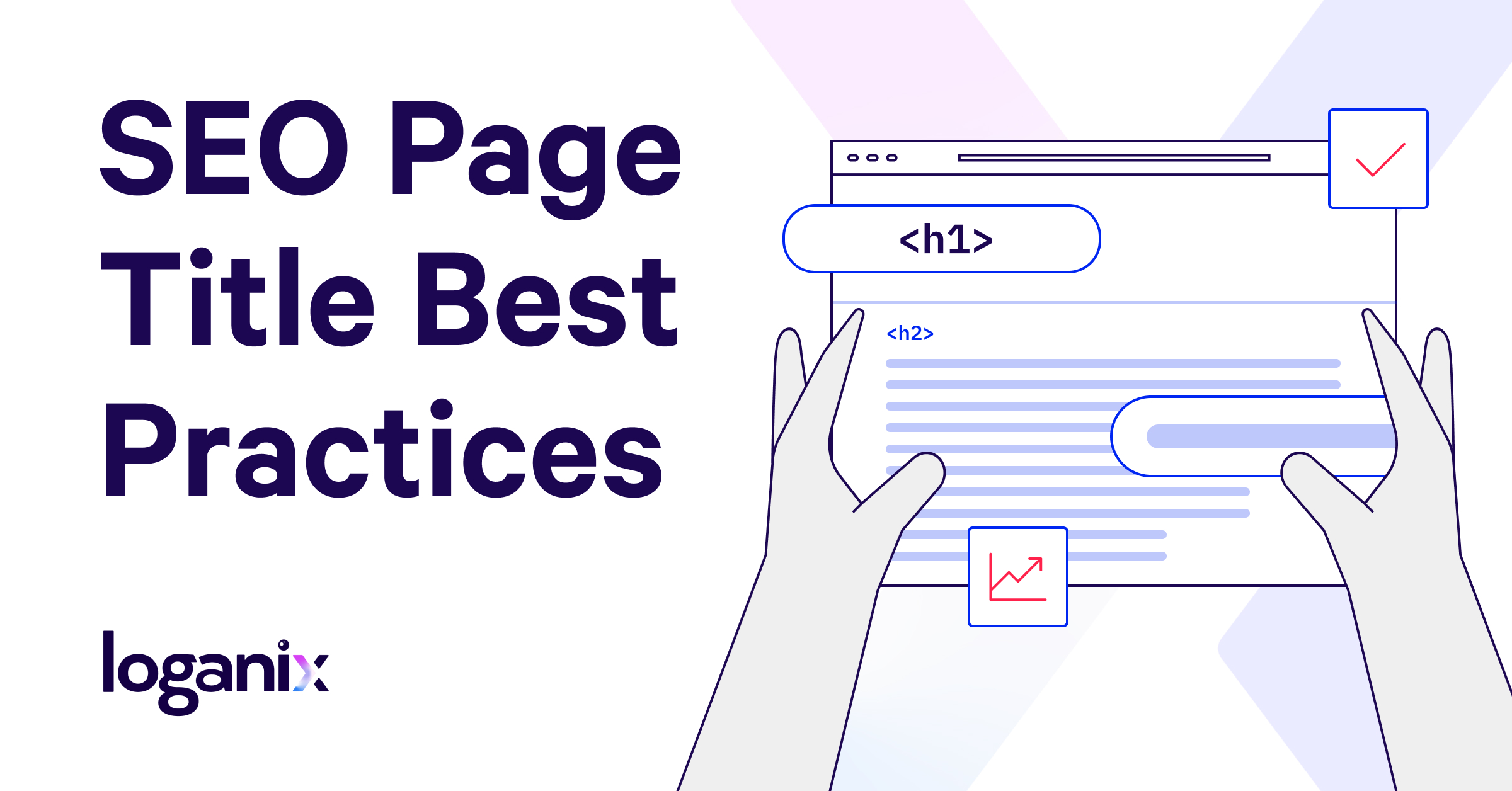
Hand off the toughest tasks in SEO, PPC, and content without compromising quality
Explore ServicesPage titles tags are a pretty straightforward SEO element, but they carry a decent amount of SEO value.
Not only do they tell Google what your page is about, they tell users too.
SEO title tag optimization is an important element to any successful SEO strategy.
It may be true that titles on their own have no direct ranking impact, but that does not mean they have no impact at all. They are a critically underutilized element of your website to be optimized.
Want to know more?
We wrote this guide on SEO page title best practices so you can get an edge on competition that ignores it.
What Are Page Titles?
Also known as title tags, page titles are a HTML element on a website page that tells search engines what title to display in search results.
Page titles in search results are the clickable links that tell you what the main topical focus of the page is.
Here is an example of the snippet a searcher would see for the search query ‘mens running shoes’:
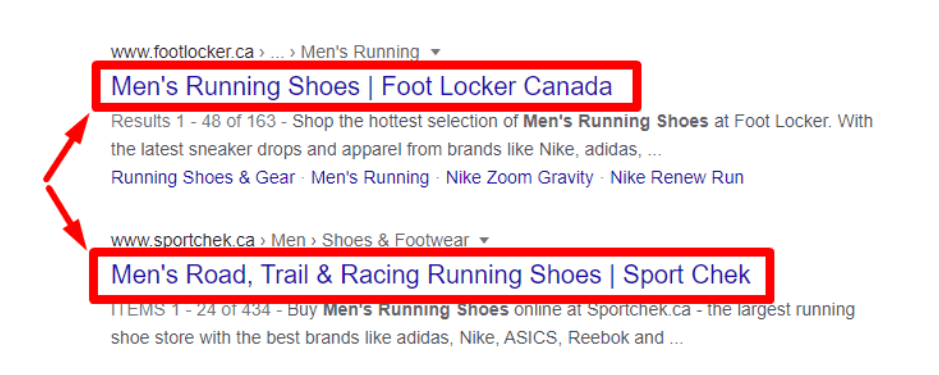
When you have a page open in a web browser, the page title is also what appears in your tab:
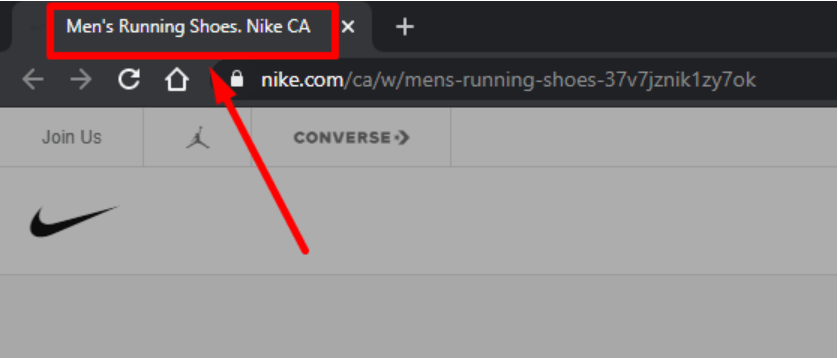
So title tags are the first indication you give to both search engines and your audience what the page is about. They also help people remember where they are when they have multiple tabs open.
Like meta descriptions, there is a bit of an argument over page titles and what role they serve in SEO. The truth is, any SEO management strategy should include optimizing every page’s title tags.
Regardless of how important you think they are, they have an undeniable impact on both search engines and your audience.
What are the differences between title tags and H1 tags?
One part of SEO that gets confused sometimes is the differences between the title tag and H1 heading tags.
As mentioned above, page titles are a piece of HTML that shows up in search results and browser tabs.
H1 tags are an important element for any SEO copywriting you do. They are the main heading that appears on the page itself. From a technical perspective, H1 tags are part of the <body> section of a page while the title tag is part of the <head> section.
The other difference is length. There is no technical limit to how long your H1 tag can be. However, the ideal SEO title length is 55 to 60 characters long. Any more than that and Google will cut it off, so users can’t see the full page title that you wrote.
Why are page titles important for SEO?
There is some disagreement about the importance of page titles for SEO. At one point, John Mueller from Google said it was not worth overhauling the title tags of your website.
“We do use it for ranking, but it’s not the most critical part of a page. So it’s not worthwhile filling it with keywords to hope that it works that way. In general, we try to recognise when a title tag is stuffed with keywords because that’s also a bad user experience for users in the search results. If they’re looking to understand what these pages are about and they just see a jumble of keywords, then that doesn’t really help.” John Mueller, Google 2016
According to him, it is not a “critical” ranking factor — by which he means your page can rank without one.
This led some people to think that they are only a minor SEO factor, or not a factor at all. However, Google has since clarified that statement. They confirm that title tags are an important ranking factor, though people still debate how “critical” it is.
I’d just write natural titles, the way you’d want them to appear in search, and how you’d want to present them for users. Slash is fine & can perform well anywhere — if you were asking about AC/DC, I’d recommend AMP ⚡.
— 🍌 John 🍌 (@JohnMu) April 23, 2020
Here’s the truth, backed up by various case studies and research.
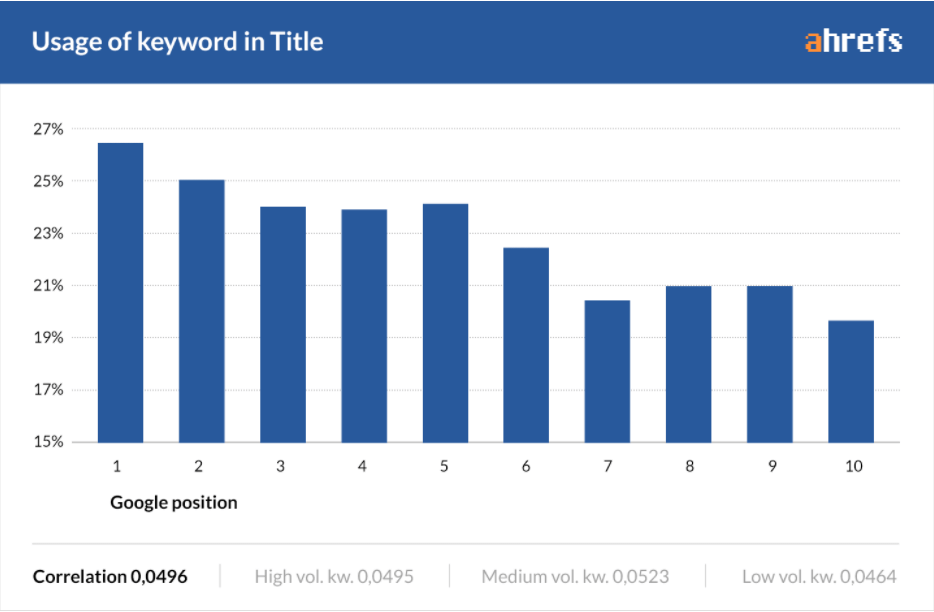
Source: https://ahrefs.com/blog/wp-content/uploads/2018/02/04-in-title.png
Your page may technically rank without a title tag, but chances are it won’t rank very well. There is a strong correlation between having a target keyword in the page title and your ranking position for that keyword.
Obviously, a page’s content, backlinks and general following of SEO best practices are going to play a big role in ranking, but meta titles remain worth your time.
Here’s why title tags are important:
- They tell your audience and search engines what your page is about.
- They act as your page’s initial sales pitch to convince them to click on your website in the SERP.
- Titles that are optimized will lead to a higher click-through rate (CTR).
- Having a higher CTR is definitely a rank factor.
Actionable SEO insights 🔍
Give us your site (or clients) and we’ll analyze the site’s SEO elements (on-page, URL equity, competitors etc), then organise this data into an actionable SEO audit.
6 SEO Page Title Best Practices
Knowing what page titles are and why they’re important is one thing. Now it’s time to learn the best practices for optimizing them. It is important to continually review your page’s SEO performance and make adjustments over time to help it rank better.
Here are 6 SEO title examples for better page title tags:
1. Draft your title tag first
The first step is to write a basic draft for what you want your title tag to include.
This should be the shortest summary of what the page is about and includes your primary keyword (more on that below).
Here are some tips on how to formulate the basic draft:
- Be descriptive: your title should give readers an accurate idea for what to expect on your page.
- Stay concise: your title tag cannot be longer than 60 characters before Google cuts it off in search results.
- Add branding: keep some space at the end to add your business or brand name so your audience recognizes you in search results.
You can play around with title tags in Excel or Google sheets using the =LEN() formula. Just select the cell you write the title tag in, and it will tell you how many characters it is as you adjust it.
2. Write for humans (not just search engines)
While title tags help inform search engine crawlers what the topical focus of your page is, keep your human audience in mind.
Just ask yourself, which is the more attractive looking page title (in terms of making someone want to click on the result)?
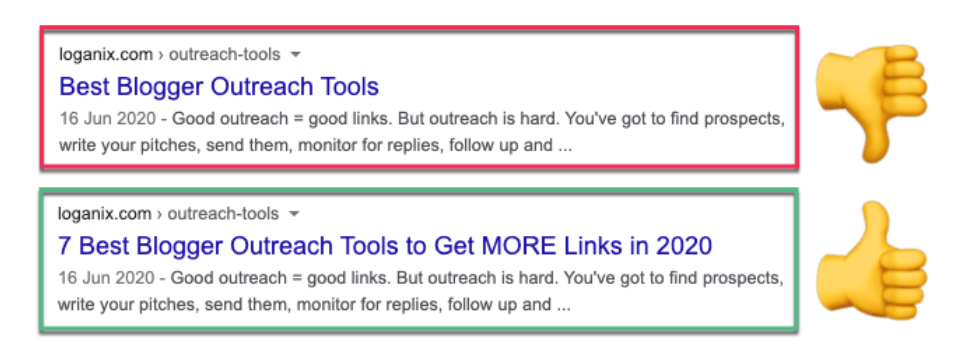
One of the best SEO tips for writing content you will hear backs that up. Just including the main keyword is all you need to do to satisfy search engines.
Otherwise, search engines also prefer ranking content that speaks authentically to humans.
That’s because such content typically gets a better CTR and other behavioural performance metrics.
Oh, and don’t do any keyword stuffing. A good title tag should read naturally and tell a user what your web page is about.
3. Make sure to use unique titles (no duplicate titles)
If you have a website with lots of pages, it can be tempting to re-use the same titles for similar pages. But this is a temptation for which you absolutely should not give in.
First, it confuses search engines and might convince them you have duplicate content.
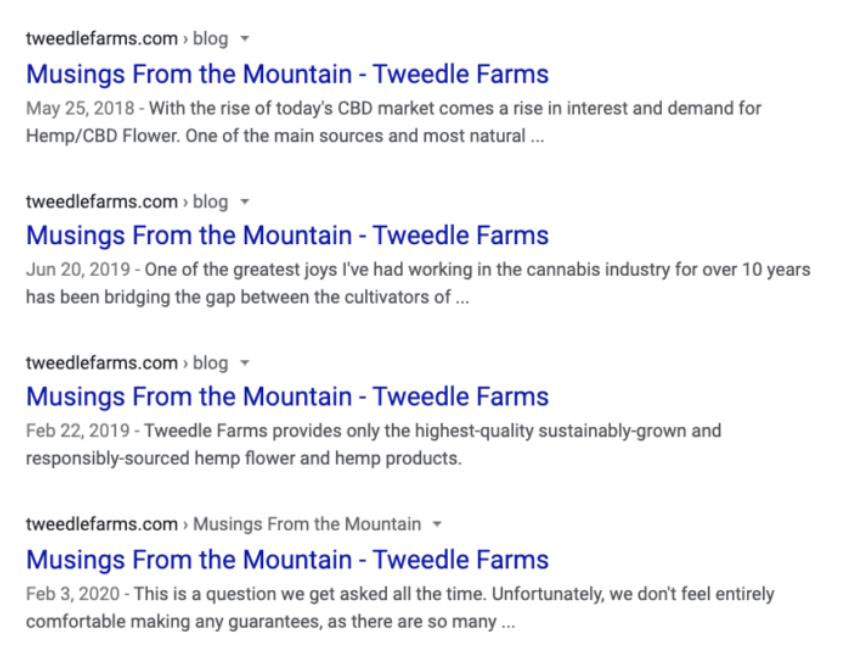
Second, duplicate titles confuse your audience.
They’re not sure which of the pages to click on, and if the first page is not what they wanted they may get frustrated and avoid your website entirely.
So make sure every page has its own title tag that indicates what is unique about the page.
4. Make sure title tags are on all pages
When you don’t have title tags, search engines will often make one for you when they display your page in search results.
That may lead you to believe that Google knows best, and it’s better to leave them blank. Maybe you only do it for some of them to save time.
Search engines did not write your page.
They do not know what the selling point of your page is, and they don’t care about optimizing it like you should. Titles written by humans, for humans, will perform better.
If you want to see what pages are missing title tags, you can use one of many technical SEO tools to crawl your site.
5. Target a keyword (+ long tail variations)
As mentioned above, there is a strong correlation between having your keyword in the page title and how well it ranks for it. Whatever the primary topic keyword for the page is, make sure it is in the title tag.
Then, look at what the best long tail variations of the main keywords are.
Pick one (or more) that has a good search volume, low competition, and best summarizes the unique content of the page. It helps improve your CTR for searches that use similar variations of the main keyword.
For example, if the primary keyword for your page is “running shoes”, you might find longtail variations that apply.
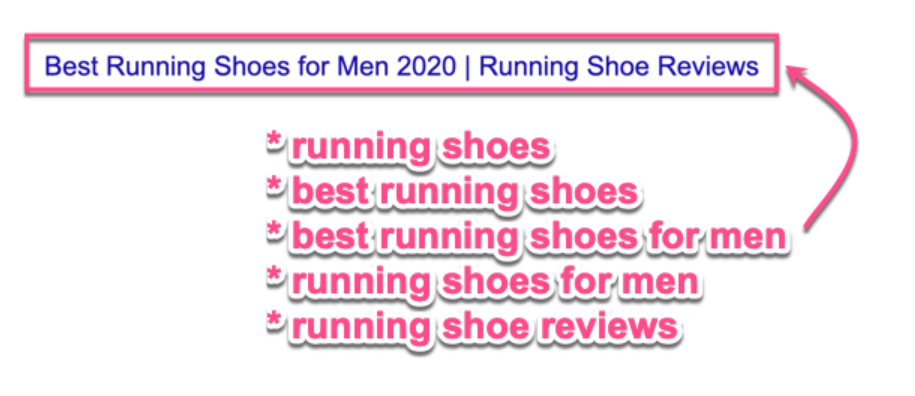
They could be things like “best running shoes”, “best running shoes of 2020”, or “nike running shoes for men”.
The point is: look for creative ways to include additional keywords in your title tag. Just make sure it reads naturally and don’t stuff them in.
6. Encourage people to click on your search result (to increase CTR)
Once your page ranks at the top of the search engine results pages, it’s time to see if you can improve on the CTR.
You can do this by adjusting the title tag to be enticing in a way that encourages your audience to click on it over your competitors.
We try to do that by employing a couple of different tactics to make our page titles stand out, like using brackets, use of capitalisation and enticing words like ‘FREE’:
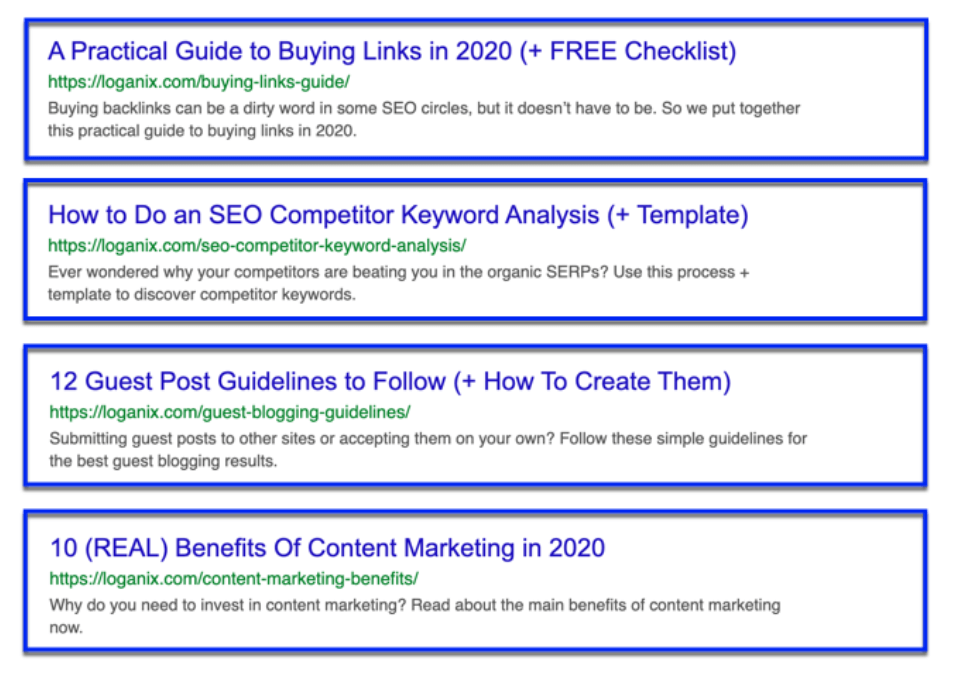
Here’s how you can achieve this with your own title tags:
- Appeal to emotion: use strong, evocative language.
- Address pain points: describe how your page will solve their problems.
- Use brackets: they break up sections of your title and are easier to read.
- Make them curious: avoid clickbait but try and hook them based on people’s desire to learn more.
- Put your keyword at the front: people will see it first based on how they scan SERPs.
5 Page Title Examples from Different Industries
Want to see some examples of great title tags in practice?
It can be helpful to use real-life examples that put all the best practices into action.
Here’s a quick list of 5 page titles written for different industries, so you have a range of ideas to use as inspiration.
1. Esquire UK

If you have a blog or news website that reviews products or services, this is a great example to follow.
First, it has the main keyword: best burgers. It adds long tail variations for the number of burgers, the city, and the year.
It also adds the brand of the website at the end, but keeps it short.
2. Farzad Law
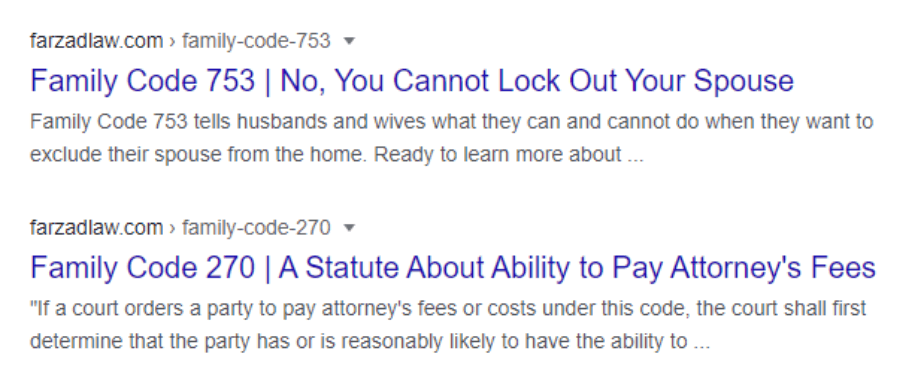
This is a great example that all lawyer businesses can follow on their website.
The title tag includes both the specific legal code term, for when someone searches for it to learn what it means.
Then they both add a little explanation that explains what the code is about. But it doesn’t fully explain it, it introduces the general idea to entice the audience to click and learn more
3. Kashoo

Kashoo is an accounting software that is marketed to small businesses. The title tag for the home page does a great job of:
- Branding: mention the business name at the start
- Main keyword: hitting “accounting for small business”
- Pain point: describing it as simple
- Specific: qualifying it as cloud-based accounting software
4. 123 Remodeling

Service-based businesses, especially in the renovation industry, often have a degree of specialization.
It’s important to include clarity in your title tags so people know what you specialize in, such as in this example below.
Kitchen and bathrooms are the most popular kind of renovating or remodeling projects. They will catch a lot of keyword variations by adding those keywords.
5. Ikea

Ikea is a well known international home furniture company. They have a lot of money to put into optimizing their web presence.
It’s often a good idea to look at major corporations in your industry to see what ideas likely work. In Ikea’s case, their title includes the main keyword for the business (furniture and home furnishings).
They have a very evocative call to action for people shopping for new furniture.
Summary
In the end, page titles are not difficult to write.
Even if your website has hundreds of pages, writing optimized title tags for each would be worthwhile, especially for targeting your important keywords. It’s just a matter of knowing what best practices to follow and then applying them.
Once you’ve written a few SEO-friendly titles, it’s easy to get into a good rhythm.
It can become formulaic, as you learn how to write titles that work for both search engines and your human audience. It can take some trial and error, but you can track your pages performance in Google Search Console. That way you learn what works and what doesn’t.
When you get better at it, you will really take your website’s SEO to the next level. You will help your pages increase their organic CTR, which in turn will help increase their rankings. That means even more traffic to drive your business online.
Really, there’s no excuse for not having great title tags.
Hand off the toughest tasks in SEO, PPC, and content without compromising quality
Explore ServicesWritten by Aaron Haynes on October 8, 2020
CEO and partner at Loganix, I believe in taking what you do best and sharing it with the world in the most transparent and powerful way possible. If I am not running the business, I am neck deep in client SEO.





